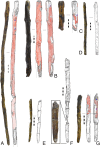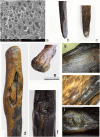Wooden tools and fire technology in the early Neanderthal site of Poggetti Vecchi (Italy) - PubMed (original) (raw)
Wooden tools and fire technology in the early Neanderthal site of Poggetti Vecchi (Italy)
Biancamaria Aranguren et al. Proc Natl Acad Sci U S A. 2018.
Abstract
Excavations for the construction of thermal pools at Poggetti Vecchi (Grosseto, Tuscany, central Italy) exposed a series of wooden tools in an open-air stratified site referable to late Middle Pleistocene. The wooden artifacts were uncovered, together with stone tools and fossil bones, largely belonging to the straight-tusked elephant Paleoloxodon antiquus The site is radiometrically dated to around 171,000 y B.P., and hence correlated with the early marine isotope stage 6 [Benvenuti M, et al. (2017) Quat Res 88:327-344]. The sticks, all fragmentary, are made from boxwood (Buxus sempervirens) and were over 1 m long, rounded at one end and pointed at the other. They have been partially charred, possibly to lessen the labor of scraping boxwood, using a technique so far not documented at the time. The wooden artifacts have the size and features of multipurpose tools known as "digging sticks," which are quite commonly used by foragers. This discovery from Poggetti Vecchi provides evidence of the processing and use of wood by early Neanderthals, showing their ability to use fire in tool making from very tough wood.
Keywords: boxwood; charring; digging stick; early Middle Paleolithic.
Conflict of interest statement
The authors declare no conflict of interest.
Figures
Fig. 1.
Poggetti Vecchi, U 2: details of the paleosurface divided by an erosion channel. The spatial distribution of wooden tools is shown; those charred are shown in black, those not charred are shown in red, and all of the other findings are shown in gray.
Fig. 2.
Poggetti Vecchi wooden tool drawings (charred parts are shown in red, blue spots indicate measurements of film thickness) and photographs. Handles: no. 2 (A), no. 9 (B), no. 50 (C), and no. 18 (D). Pointed tips: no. 55 (E), no. 41 (F), and no. 3+28 (G).
Fig. 3.
(A) SEM image of the cross-section of the charred outer layer of one (49b) of the Poggetti Vecchi sticks made from B. sempervirens. The anatomical structure of boxwood is unchanged; however, with respect to fresh wood, the cell walls of its fibers and vessels are thinner, homogeneous, and compact despite the handmade fracture surface. This is the typical aspect of charred wood at SEM. (B) Removal of a splinter starting from the tip of point no. 3+28. (C) Notch on the tip of point no. 41. (D) Detail of handle no. 2. (E) Detail of handle no. 50. (F) Detail of flattened knot of stick no. 9. (G) Scratches on stick no. 14. (H) Cut marks on stick no. 2. (I) Cut marks located in the area of the knot on stick 33.
Comment in
- The complexity of Neanderthal technology.
Hoffecker JF. Hoffecker JF. Proc Natl Acad Sci U S A. 2018 Feb 27;115(9):1959-1961. doi: 10.1073/pnas.1800461115. Epub 2018 Feb 12. Proc Natl Acad Sci U S A. 2018. PMID: 29440434 Free PMC article. No abstract available.
Similar articles
- A Middle Palaeolithic wooden digging stick from Aranbaltza III, Spain.
Rios-Garaizar J, López-Bultó O, Iriarte E, Pérez-Garrido C, Piqué R, Aranburu A, Iriarte-Chiapusso MJ, Ortega-Cordellat I, Bourguignon L, Garate D, Libano I. Rios-Garaizar J, et al. PLoS One. 2018 Mar 28;13(3):e0195044. doi: 10.1371/journal.pone.0195044. eCollection 2018. PLoS One. 2018. PMID: 29590205 Free PMC article. - Poggetti Vecchi (Tuscany, Italy): A late Middle Pleistocene case of human-elephant interaction.
Aranguren B, Grimaldi S, Benvenuti M, Capalbo C, Cavanna F, Cavulli F, Ciani F, Comencini G, Giuliani C, Grandinetti G, Mariotti Lippi M, Masini F, Mazza PPA, Pallecchi P, Santaniello F, Savorelli A, Revedin A. Aranguren B, et al. J Hum Evol. 2019 Aug;133:32-60. doi: 10.1016/j.jhevol.2019.05.013. Epub 2019 Jun 21. J Hum Evol. 2019. PMID: 31358183 - The wooden artifacts from Schöningen's Spear Horizon and their place in human evolution.
Leder D, Lehmann J, Milks A, Koddenberg T, Sietz M, Vogel M, Böhner U, Terberger T. Leder D, et al. Proc Natl Acad Sci U S A. 2024 Apr 9;121(15):e2320484121. doi: 10.1073/pnas.2320484121. Epub 2024 Apr 1. Proc Natl Acad Sci U S A. 2024. PMID: 38557183 Free PMC article. - The Acheulian and Early Middle Paleolithic in Latium (Italy): Stability and Innovation.
Villa P, Soriano S, Grün R, Marra F, Nomade S, Pereira A, Boschian G, Pollarolo L, Fang F, Bahain JJ. Villa P, et al. PLoS One. 2016 Aug 15;11(8):e0160516. doi: 10.1371/journal.pone.0160516. eCollection 2016. PLoS One. 2016. PMID: 27525705 Free PMC article. - The Paleolithic in the Nihewan Basin, China: Evolutionary history of an Early to Late Pleistocene record in Eastern Asia.
Yang SX, Deng CL, Zhu RX, Petraglia MD. Yang SX, et al. Evol Anthropol. 2020 May;29(3):125-142. doi: 10.1002/evan.21813. Epub 2019 Dec 20. Evol Anthropol. 2020. PMID: 31859441 Review.
Cited by
- Surface Characteristics of One-Sided Charred Beech Wood.
Machová D, Oberle A, Zárybnická L, Dohnal J, Šeda V, Dömény J, Vacenovská V, Kloiber M, Pěnčík J, Tippner J, Čermák P. Machová D, et al. Polymers (Basel). 2021 May 12;13(10):1551. doi: 10.3390/polym13101551. Polymers (Basel). 2021. PMID: 34066234 Free PMC article. - Beyond the main function: An experimental study of the use of hardwood boomerangs in retouching activities.
Martellotta EF, Perston YL, Craft P, Wilkins J, Langley MC. Martellotta EF, et al. PLoS One. 2022 Aug 16;17(8):e0273118. doi: 10.1371/journal.pone.0273118. eCollection 2022. PLoS One. 2022. PMID: 35972969 Free PMC article. - Measuring ancient technological complexity and its cognitive implications using Petri nets.
Fajardo S, Kozowyk PRB, Langejans GHJ. Fajardo S, et al. Sci Rep. 2023 Sep 22;13(1):14961. doi: 10.1038/s41598-023-42078-1. Sci Rep. 2023. PMID: 37737280 Free PMC article. - A Middle Palaeolithic wooden digging stick from Aranbaltza III, Spain.
Rios-Garaizar J, López-Bultó O, Iriarte E, Pérez-Garrido C, Piqué R, Aranburu A, Iriarte-Chiapusso MJ, Ortega-Cordellat I, Bourguignon L, Garate D, Libano I. Rios-Garaizar J, et al. PLoS One. 2018 Mar 28;13(3):e0195044. doi: 10.1371/journal.pone.0195044. eCollection 2018. PLoS One. 2018. PMID: 29590205 Free PMC article. - No Country for Oldowan Men: Emerging Factors in Language Evolution.
Murphy E. Murphy E. Front Psychol. 2019 Jun 19;10:1448. doi: 10.3389/fpsyg.2019.01448. eCollection 2019. Front Psychol. 2019. PMID: 31275219 Free PMC article. Review.
References
- Benvenuti M, et al. Paleoenvironmental context of the early Neanderthals of Poggetti Vecchi for the late middle Pleistocene of Central Italy. Quat Res. 2017;88:327–344.
- Thieme H. Lower Palaeolithic hunting spears from Germany. Nature. 1997;385:807–810. - PubMed
- Schoch WH, Bigga G, Böhner U, Richter P, Terberger T. New insights on the wooden weapons from the Paleolithic site of Schöningen. J Hum Evol. 2015;89:214–225. - PubMed
- Oakley K, Andrews P, Keeley L, Clark J. A reappraisal of the Clacton spearpoint. Proc Prehist Soc. 1977;43:13–30.
- Thieme H, Veil S. 1985. Neue Untersuchungen zum eemzeitlichen Elefanten-Jagdplatz Lehringen. Ldkr Verden Die Kunde 36:11–58. German.
Publication types
LinkOut - more resources
Full Text Sources
Other Literature Sources


